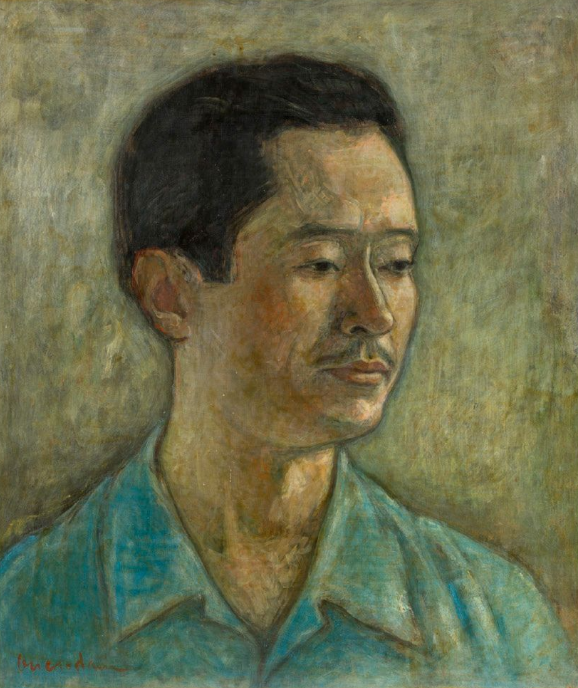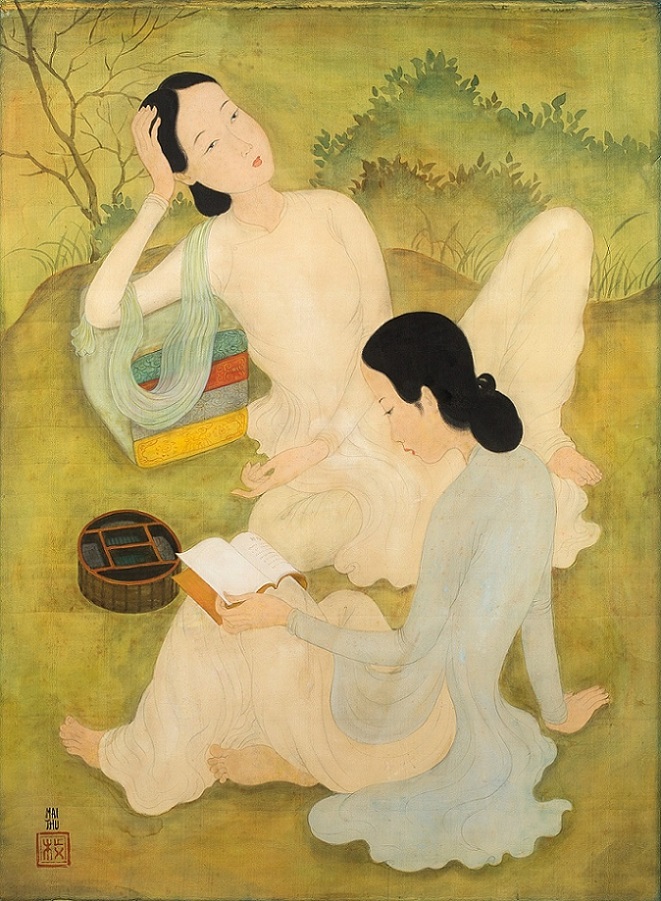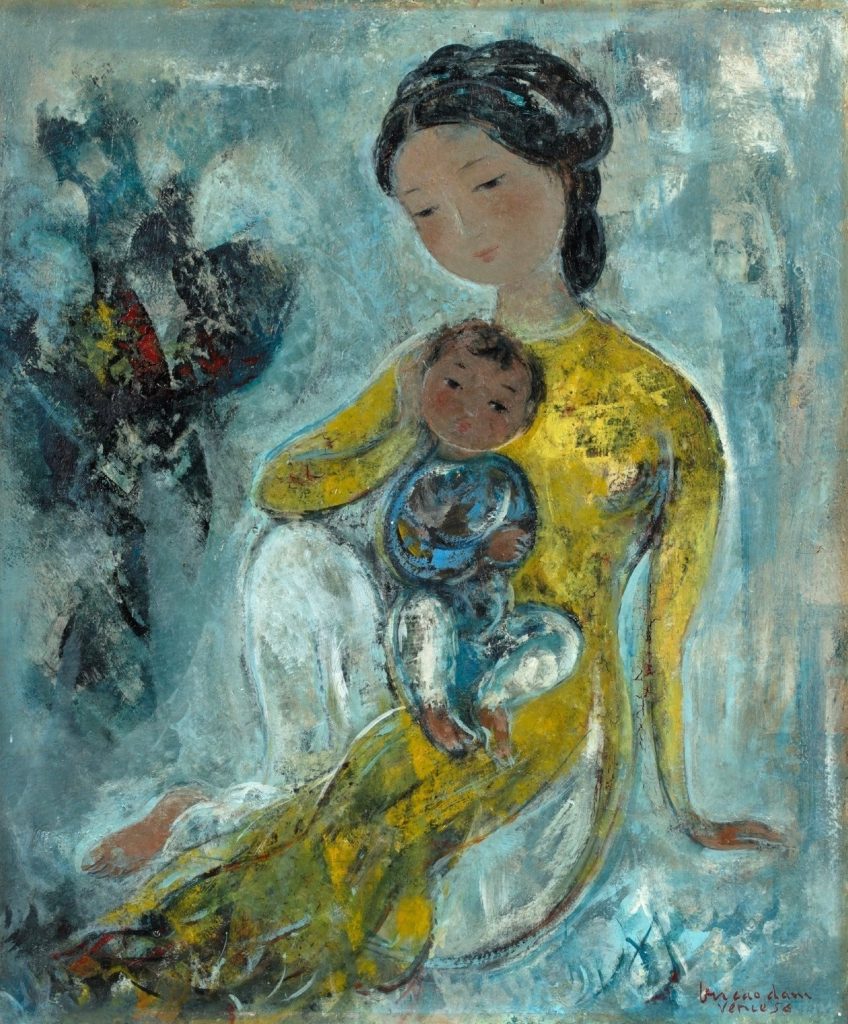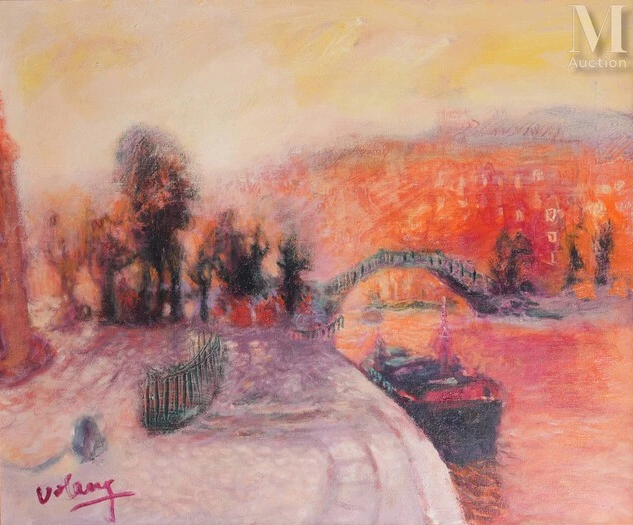
As 2024 celebrates the centenary of the founding of the Indochina School of Fine Arts by Victor Tardieu (1870-1937), Charlotte Aguttes-Reynier presents her 42nd sale dedicated to Asian Painters on March 7, featuring the Collection of Nguyễn Hữu Hợp and Nguyễn Nguyệt Nga, relatives Bảo Đại (1913-1997).
A European precursor on the market for artists from Asia, the expert published L’Art Moderne en Indochine, February 14, 2024, with In Fine Editions.
BOOK LAUNCH | MODERN ART IN INDOCHINA. THE INDOCHINA SCHOOL OF FINE ARTS (1925-1945)
On 14 February 2024, In fine éditions d’art will publish L’art moderne en Indochine, a book conceived and written by Charlotte Aguttes-Reynier, an expert at Aguttes.
This publication, the first to offer an overview of the role of the Indochina School of Fine Arts in artistic creation, will be a landmark publication. It appears on the eve of the centenary of this institution, a veritable link between East and West.

42ND SALE DEDICATED TO ASIAN PAINTERS
A THREE-WEEK PUBLIC EXHIBITION OF RARE WORKS FROM EUROPEAN PRIVATE COLLECTIONS
« In 1924, one hundred years ago, Victor Tardieu submitted a report to Governor General Martial Merlin on the need to open a fine arts school in Hanoi. The report was accepted, and the school was established in October of the same year, with the first class of selected students entering the profession in the autumn of 1925.
In 2014, ten years ago, Aguttes discovered in Paris the work Le Thé by Lê Phổ (one of the students of this first class). The auction house decided to give it special visibility, which enabled it to achieve a fair sale price and was responsible for reawakening a market that had been dormant since the mid-twentieth century.» Charlotte Aguttes-Reynier, expert
Since 2014, around 1,000 works related to modern Asian art, including almost 150 paintings by Lê Phổ, over 115 works by Mai Trung Thứ and almost 100 works executed by Vũ Cao Đàm, have passed through the hands of Charlotte Aguttes-Reynier. Most of the works in each catalog are new to the art market, as shown by this Jeune femme au tricot by Lương Xuân Nhị.
Born in Hanoi in 1914, Lương Xuân Nhị occupies a major place within the Vietnamese artistic sphere of the 20th century; he uses a modernity giving his production a singular and personal character. He graduated from the Indochina School of Fine Arts in 1937. A member of the Société d’encouragement à l’art et à l’industrie, from which he received several awards, he was also one of the founders of FARTA (Foyer de l’art annamite), along with artists To Ngoc Van, Tran Van Can and Le Van De. From 1955 to 1981, Lương Xuân Nhị taught at the University of Fine Arts of Indochina. He exhibits both in Vietnam and abroad in cities such as Paris, New York and Tokyo, and as a member of various organizations, he regularly travels to Europe. Renowned for his rural landscapes and his paintings of women, the artist distinguishes himself with his chromatic range and delicate touch. For Jeune femme au tricot, he has also used intense, vibrant colors, lending great richness to his composition.

LƯƠNG XUÂN NHỊ (1914-2006), Jeune femme au tricot
Oil on canvas, signed upper left, 61 x 46 cm
Provenance : French private collection (acquired in Saigon in 1950 and brought back to France)
Private collection, South-West France (transferred from previous owner in 1975)
COLLECTION OF NGUYỄN HỮU HỢP AND NGUYỄN NGUYỆT NGA, RELATIVES BẢO ĐẠI (1913-1997)
The catalog of this 42nd opus unveils the Collection of Nguyễn Hữu Hợp and Nguyễn Nguyệt Nga, close to the imperial family, and in particular to Bảo Đại, the last emperor of Vietnam. Living between France and Vietnam from 1948, this couple forged friendships with several illustrious Vietnamese artists, Mai Trung Thứ, Vũ Cao Đàm, Lê Thị Lựu and her husband Ngô Thế Tân. Keen to support these artists in their work, they commissioned several portraits from them, which have remained in the family collection to this day. The two framed works have retained their original frames chosen by the artist.
Mai Trung Thứ took great care with the portrait of Madame Nguyễn Nguyệt Nga, painted in 1950. It is a commissioned portrait, an unusual exercise for the artist. This sensitive work expresses feminine softness and beauty in all its simplicity. The woman, depicted in a carefully decorated interior, poses with the elegance befitting her social status. Seated on a stool, arms and legs crossed, she holds a leaflet in her hand. The refinement of her outfit is matched only by the finesse of the decoration adorning the carpet, or that of the ravishing pointed slipper. Her hand, delicately crossed over her mauve-toned ao-daï over white pants, is adorned with a beautiful diamond, a rare detail in the artist’s work. She also wears a necklace of jade pearls. Behind her, on a chest of drawers, rest a vase of flowering branches and two books. Having abandoned the oil painting of his early days, Mai Trung Thứ explored silk painting, the technique of which he quickly mastered. He applies the color, which he then softens with successive washes: mauve and creamy white contrast subtly with the ochre and green hues of the background. This composition is extremely charming, immortalizing the artist’s collector friend and patron, Nguyễn Nguyệt Nga. The choice of colors creates a warm, evocative atmosphere, transporting the viewer into a moment of calm and tranquility. The woman’s hair delicately pulled up into a bun, her lips covered in red make-up and her posture make her the embodiment of the elegance and refinement of Vietnamese high society.

MAI TRUNG THỨ (1906-1980), Portrait de Madame Nguyễn Nguyệt Nga, 1950
Encre et couleur sur soie, signée et datée en haut à gauche, 61 x 46 cm
Provenance : Collection de Nguyen Huu Hop et Nguyen Nguyet Nga
Collection particulière, région parisienne (par descendance du précédant vers 1965-1970)
Born in Hanoi, Vũ Cao Đàm was one of the artists to make his home in the South of France, a popular land of exile for twentieth-century artists; he settled in France shortly before the Second World War. Although he graduated top of his class in the sculpture department, the artist gradually turned to painting as his preferred form of expression. The volumes of the Chrysanthemums recall his early predilection for sculpture.

VŨ CAO ĐÀM (1908-2000), Les chrysanthèmes, 1949
Encre et couleur sur soie, signée et datée en bas à droite, 46 x 54,7 cm
Provenance : Collection de Nguyen Huu Hop et Nguyen Nguyet Nga
Collection particulière, région parisienne (par descendance du précédant vers 1965-1970)
A portraitist, he also created two portraits of his collector friend and patron, Mr Nguyễn Hữu Hợp.

VŨ CAO ĐÀM (1908-2000),Portrait de Monsieur Nguyễn Hữu Hợp
Oil on silk, signed lower left, 53.5 x 44.8 cm
Provenance : Collection of Nguyễn Hữu Hợp and Nguyễn Nguyệt Nga
Private collection, Paris region (by descent from the previous owner circa 1965-1970)

VŨ CAO ĐÀM (1908-2000), Portrait de Monsieur Nguyễn Hữu Hợp, 1951
Oil on canvas, signed and dated lower right, 41 x 33 cm
Provenance : Collection of Nguyễn Hữu Hợp and Nguyễn Nguyệt Nga
OTHER RARE WORKS FROM EUROPEAN PRIVATE COLLECTIONS
“Young Woman with Carnations” depicts a young woman in a traditional ao dai. She was smelling the gentle fragrance emanating from the red and white carnations. Le Pho is known for his iconic personal style. Through his works, one can see the influence of classical Italian painters of the Quattrocento period and Vietnamese painting style.
Here, the artist created an emotional peace using solid colors, delicate lines, soft shapes, and three-quarter portraits, evoking the influence of Italian art. As a symbol of longevity and eternal happiness, the scent of carnations makes the woman immersed in dreams and thoughts.

LÊ PHỔ (1907-2001), Femme aux œillets
Ink and color on silk, signed upper right, titled and numbered on reverse
64.1 x 44.9 cm
Dans le jardin is part of a major turning point in Lê Phổ’s pictorial research, at a time when he was in the midst of his aesthetic quest. The painting manifests the syncretism of various influences. The artist chose to keep silk as his support, a medium that is very difficult to master and allows no repentance. What’s more, the artist uses a motif that is highly significant of his country: a young woman picking peach boughs stands behind a mother and son. This peaceful scene highlights the importance of this fruit tree in Vietnam. Now an integral part of the Tet festival, celebrating the Lunar New Year, peach branches and blossoms originally symbolized immortality. Announcing the arrival of spring, they bring good luck and prosperity, and for many people they offer a new source of vitality, keeping household members in good health.

LÊ PHỔ (1907-2001), Dans le jardin
Oil on silk, signed lower right, titled on back 46.3 x 33.3 cm
Provenance: Galerie Romanet, Paris
Private collection, France (acquired from previous owner in the late 1950s)
Private collection, South-East France (acquired from previous owner circa 1985)
Produced in the early 1940s, En plein air allows Mai Trung Thứ to exalt the beauty of his models. One absorbed in her reading, the other lost in her daydreams. Dressed in áo dài, which emphasizes their graceful curves and slender waists, they wear a chignon. With their lips covered in red make-up, these two exquisitely elegant and refined women exemplify Vietnamese canons. The accessories used in the composition complete this Vietnamese vision: the armrest cushions and the small box. While Far Eastern influence permeates this work, the artist also draws inspiration from European art. While the artist has made a name for himself with his fashion illustrations in Vietnamese specialist magazines, the young women’s outfits also evoke the wet-fold drapery of Greek statuary. The movement, particularly the twisting of the body along a serpentine line, echoes the Italian Mannerists of the 16th century.

MAI TRUNG THỨ (1906-1980)
En plein air, circa 1940-1945
Ink and colors on silk, signed lower left, titled on back
73 x 53.8 cm
This painting narrates a scene from Vũ Cao Đàm’s family life: Marguerite, the artist’s grandniece plays with a hen and chicks in a garden. This work brings together the syncretism of Vũ Cao Đàm’s pictorial style, between the forms and perspective of Western art taking up the genre scene, and the traditions of Vietnamese silk painting. Here, the artist immortalizes a genre scene set in Béziers probably during the summer of 1951. The roosters symbolize bravery, courage and male virility, while the hens and chicks could represent family life for the artist, illustrating the values of Vietnamese society.
“For me it’s more about my little cousin Marguerite, the eldest daughter of my first cousin Anna. At the time, we lived in neighboring houses, and my cousin by marriage Do Dinh Can raised chickens in the garden. She was about five years old, while I was 9 in ’51. » Yannick Vu-Jakober, daughter of the artist

VŨ CAO ĐÀM (1908-2000)
Marguerite au jardin jouant avec les poussins, circa 1950-1951
Ink and colors on silk, signed lower right, 55 x 43 cm
Provenance : Collection of Dr. Nguyen Van Tung, a friend of the artist whom he met in Paris in the 1930s
(acquired in August 1956, then passed on by descent)
Private collection, France (acquired in 2000)
Born in Hanoi in 1908 to a French-speaking, Francophile father, Vũ Cao Đàm grew up in a scholarly environment. He entered the Indochina School of Fine Arts. Initially showing a keen interest in sculpture, which he practiced assiduously, it was finally with silk painting that Vũ Cao Đàm expressed his talent. In both fields, the artist concentrates above all on the human figure, which he magnifies in portraits or charming genre scenes. Often treating the theme of maternity and childhood, he depicts, Marguerite au jardin jouant avec les poussins, his little niece, whose candor he paints with tenderness, while in Maternité he depicts a mother and her infant.

VŨ CAO ĐÀM (1908- 2000), Maternité, 1956
Oil on panel signed, located and dated lower right, titled, dated and located on back
53.5 x 45 cm
The back of the panel features two overpainted sketches of a horseman surrounded by three figures at the top, and two female figures at the bottom.
Provenance : Private collection, Southwest France (acquired by the current owner in Saint Paul de Vence in 1956)
From the 1950s onwards, Mai Trung Thứ began to simplify silhouettes and round out faces, while backgrounds gave way to neutrality. These changes became more pronounced in the 1960s and are particularly evident in the works of the 1970s. Grand-mère, created in 1976, is also marked by a different vision of color, revealing pinks, blues and oranges that cheerfully shimmer through the composition, while the background, brushed with a blue-green gradation, enhances this colorful palette.

MAI TRUNG THỨ (1906-1980), Grand-mère, 1976
Ink and colors on silk, signed and dated upper right
In the original frame made by the artist
22 x 47 cm
Auction
Aguttes Neuilly
Thursday, March 7, 2024, 14h30 [France]
Public exhibition
From Monday, February 12 to Wednesday, March 6
10h – 12h and 14h – 17h30 (except weekends)
Recommended to make an appointment in advance for a tour with an expert
Contact
Charlotte Aguttes-Reynier – Expert
+33 1 41 92 06 49 – reynier@aguttes.com
Source: Aguttes







